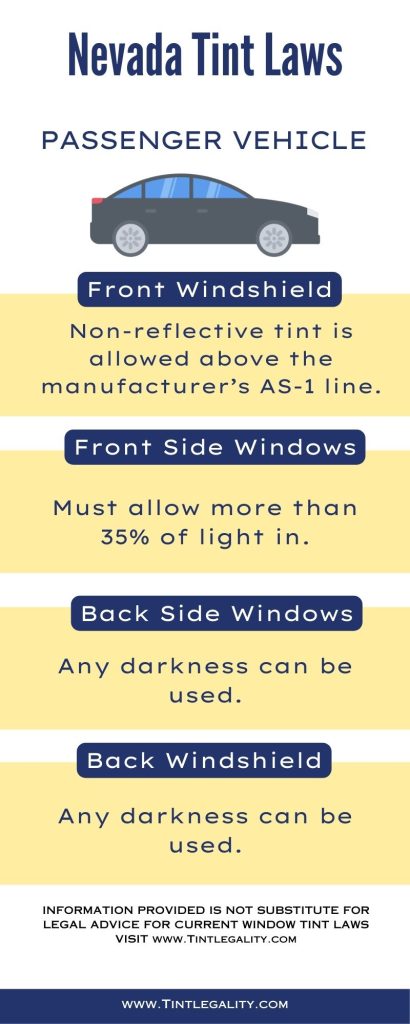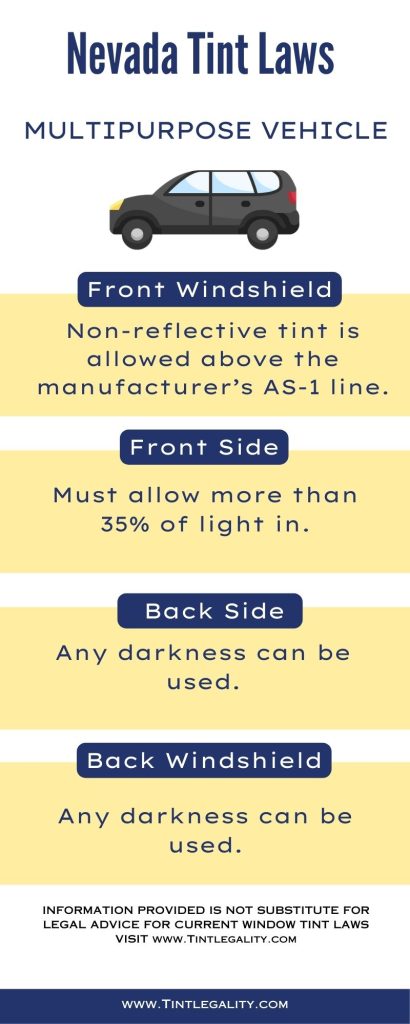Did you know that Nevada tint laws were enacted as far back as 1993?
For those not in the know, window tinting is not just a matter of aesthetics.
It has to do with safety, health, and compliance with the law.
Here’s what you need to know.
Regulations Regarding Window Tint in Nevada
Nevada tint laws, like those of many other states, vary depending on the type of vehicle and the specific window.
They measure the percentage of visible light allowed in through the combination of window glass and the window tint film.
This measurement is known as VLT% (Visible Light Transmission).
Let’s break down these regulations.
| Car Section | Sedan | SUV and Vans |
|---|---|---|
| Windshield | Non-reflective tint above AS-1 line | Non-reflective tint above AS-1 line |
| Front Side Windows | Must allow more than 35% of light in | Must allow more than 35% of light in |
| Back Side Windows | No restriction | No restriction |
| Rear Window | No restriction | No restriction |
Windshield
For windshields, a non-reflective tint is allowed along the top of the windshield above the manufacturer’s AS-1 line.
This means that the part of the windshield where the rearview mirror is located can be tinted as long as the tint does not interfere with the driver’s visibility.
Front Side Windows
When it comes to the front side windows of your vehicle, whether it’s a sedan, SUV, or van, the law is straightforward.
The windows must allow more than 35% of light in.
This law is designed to ensure that drivers have a clear view of pedestrians and other vehicles on the road.
Back Side Windows
Here’s where things get a bit more flexible.
For both sedans and larger vehicles like SUVs and vans, the law does not specify maximum darkness for tints on the back side windows.
This means that you could opt for a darker tint for privacy or comfort.
Rear Window
Just like the back side windows, the laws for the rear window do not specify maximum darkness for tints.
The key consideration is visibility, especially when backing up, so there’s a requirement that vehicles have dual side mirrors if the back window is tinted.


Additional Regulations
Beyond these specific window rules, there are a few more regulations you should be aware of.
For example, Nevada does not allow red or amber window tint colors.
There is a tolerance of 7% light transmission variance allowed by state laws.
Reflection
The reflective quality of your tint matters too.
While some states have specific laws about reflectivity, Nevada laws do not specify restrictions for reflection on front side and back side windows.
This can help to deflect incoming light and reduce heat and glare.
Medical Exemptions
In some cases, darker tints might be necessary for medical reasons.
Nevada law provides for such medical exemptions, which you can apply for through the Nevada Department of Public Safety.
Color Restrictions
You might love the look of a certain color tint, but before you make that decision, keep in mind that Nevada does not allow the colors red and amber for your window tint.
Side Mirrors
Don’t forget about your side mirrors!
If the back window is tinted, dual side mirrors are a must-have according to Nevada tint laws.
Exceptions to Legal Limits
While the tint laws apply to most situations, exceptions do exist.
These could be due to medical reasons or other special circumstances.
However, these exceptions are granted on a case-by-case basis and require appropriate documentation.
Penalties for Breaking the Law
No one wants to be on the wrong side of the law.
If you’re caught with illegal tint in Nevada, you can expect to face the following penalties:
Fines
First Conviction
The fine for a first conviction is not more than $100.
Second Conviction
A second conviction, within six months of the first, comes with a fine of not more than $250.
Third Conviction
A third conviction within six months of the first raises the fine to not more than $500.
Other Penalties
Beyond fines, there could be other penalties for non-compliance.
For example, you might be required to remove the illegal tint from your vehicle, which could come with additional costs.
Repeated offenses might also lead to points on your driving record, which could increase your insurance premiums.
In short, it pays to be aware of Nevada window tint laws and to ensure that your vehicle is in compliance.
By doing so, you’ll avoid penalties, ensure your safety on the road, and enjoy the benefits of tinted windows in the bright Nevada sun.
Stay cool and drive safe!
References:
https://en.wikipedia.org/wiki/Nevada